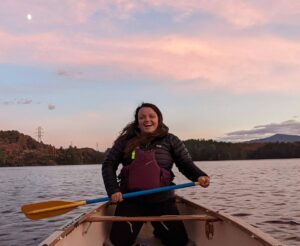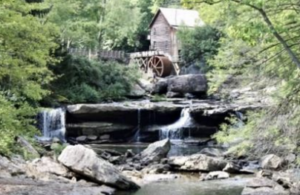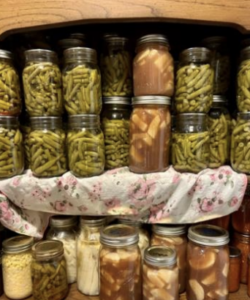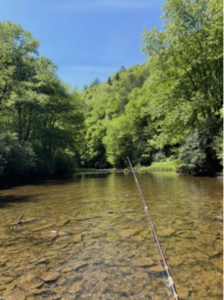Out of the Frying Pan and Into the Fire: The Struggle for a Sustainable Transition in Appalachia
About the author

Katy Pompili (she/her) is an Outdoor Environmental and Sustainability Education graduate from the United States. Before moving to Scotland, she earned a bachelor’s degree in Public Health and worked as an outdoor and environmental educator throughout the US including the Pacific Northwest, Appalachian Region, Rocky Mountain West, and Alaska.
Katy is passionate about sharing the more-than-human world with others and understanding the intersectionality of environmentalism, education, and public health. In her free time, she enjoys trail running, climbing, skiing, and hanging out in cute coffee shops.
If you would like to get in contact with Katy, you can email her at kepompili@gmail.com or connect on Instagram at @katy_pompili.
Background
My relationship with West Virginia and Appalachia has long been complicated. Growing up in the region, I remember vividly when the local power plant shut down when I was in middle school and my friends’ parents lost their jobs. I can remember being told to stay away from the bright orange water that would come down from the hillsides; acid mine drainage from within the rolling hills and hidden by a forest from the public. Still today, I call my parents to hear about “how bad the water is” coming out of the tap “a light rust colour.” I have read the articles released by major news companies after the 2016 election detailing how Appalachia and the South are to blame for the problems that are about to occur in the United States and listened to the stereotypes others expect of me.
West Virginia and Appalachia have long been exploited for their natural resources (DeYoung, 1995; Fisher & Smith, 2012; Force, 2014; Hess et al., 2021). The natural resources in Appalachia’s mountains and valleys have fuelled American progress at the cost of those who performed the labour and called the region home (Morrone et al., 2011). The unequal power distribution between the labourers, communities, and extractive industries have created the environmental justice issues the region faces and assisted with the spread of the concept that people from this region are resistant to environmental and sustainable change (Clark & Harley, 2020; McClanahan, Bill, 2017; Morrone et al., 2011). A story has been pushed into popular culture that depicts Appalachians as “uneducated”, “racist”, “hillbillies” that “consistently vote against their own needs” (Gonyea, 2012; Hackney, 2021; Morrone et al., 2011). However, the true narrative is much deeper. While there is general struggle in environmental movements in the region, the reasoning is deeper than “being uneducated hillbillies.”
When it came to deciding a research topic, I decided I wanted to look more in depth into this phenomenon, what it means for the region and the individuals living there. As I began my research, I found that a vast majority of literature on these topics were outdated and perpetuated stereotypes and misconceptions I identified research gaps, which included literature outlining how to create solutions in Appalachia that tackled environmental injustices at the root cause, a general lack of Appalachian voices being shared within the literature, a lack of research investigating of misconceptions and stereotypes’ effect on the progress towards a just and sustainable transition in Appalachia (Brock Carlson & Caretta, 2023; Ciplet & Harrison, 2020; Hess et al., 2021; McClanahan, 2017; Tingler, 2021). Appalachian voices have been silenced, especially when speaking up for their well-being and future (Canter, 2016; Nardella, 2022). By “othering” the individuals in the region, their stories were no longer taken seriously, and their narratives as constructed by outside entities were taken as fact.
My Research
The aims of my research were a) examine the impact of misconceptions and stereotypes on environmental justice and the progress towards sustainable transition in Appalachia, b) unveil Appalachian’s relationships to their environment and community c) comprehend the hope for the future of Appalachia. Knowing that studying Appalachia would be a study of the oppression that has occurred in the region, I wanted my paradigm, methodology and methods to work in a positive direction. I felt that the feminism paradigm aligned best with my research goals and the context of my aims. The primary reasons were the feminism paradigm emphasis on exploring power dynamics, elevating voices of marginalised communities, intersectionality, and its drive for social change and activism (Haraway, 1988; Hesse-Biber, 2013; Hesse-Biber & Leavy, 2007; hooks, 2014). I conducted a narrative inquiry through interviews, photovoice, and art elicitation. My methods were chosen for their ability to connect and cross barriers and allow for deeper understanding of the stories they shared with me (Brock Carlson & Caretta, 2023; Brock Carlson & Caretta, 2021; Wang & Burris, 1997). I’ve included some of those photos here with their stories read by myself.



Some key takeaways included:
a) misconceptions still play a negative role in not only the external treatment of Appalachia, but also individuals’ perceptions on the effects and changes they can make,
b) exposing and rejecting these misconceptions and misrepresentations can help add traction to positive forward progression,
c) as Appalachians have strong senses of place, the foundation for environmental citizenship is there and can be cultivated to encourage sustainable behaviours and
d) the pride and love for Appalachia strongly exists within its residents despite the environmental, economic, and political turmoil. This provides a strong support for positive future progression.
Larger than Appalachia
While I chose to focus on Appalachia, I think it’s important to remember that “Appalachias” exist around the globe. As we look towards finding solutions for the climate crisis, we must ask ourselves, “Who is not at table and why aren’t they there?” It is of my personal belief that a large portion of the climate change movement will rely upon meeting communities, such as those in Appalachia, where they are and helping promote just transitions through job trainings (from fossil fuel industries to a green economy), helping promote tourism opportunities, and, most importantly, listening and addressing the primary needs of communities to allow for these changes to occur.
References
Brock Carlson, E., & Caretta, M. A. (2023). Collaborative sensemaking through photos: Using photovoice to study gas pipeline development in Appalachia. Qualitative Research, 14687941221149582. https://doi.org/10.1177/14687941221149582
Canter, A. (2016). A Double-Sided Mirror: ‘Otherizing’ and Normalizing the Silenced Voices of Appalachian Women. Bridges: A Journal of Student Research, 10(10). https://digitalcommons.coastal.edu/bridges/vol10/iss10/1
Ciplet, D., & Harrison, J. L. (2020). Transition tensions: Mapping conflicts in movements for a just and sustainable transition. Environmental Politics, 29(3), 435–456. https://doi.org/10.1080/09644016.2019.1595883
Erin Brock Carlson & M.A. Caretta. (2021). Legitimizing situated knowledge in rural communitites through storytelling around gas piplines and environmental risk. Technical Communication Quarterly, 68(4), 40–55.
Haraway, D. (1988). Situated Knowledges: The Science Question in Feminism and the Privilege of Partial Perspective. Feminist Studies, 14(3), 575–599. https://doi.org/10.2307/3178066
Hess, D. J., McKane, R. G., & Belletto, K. (2021). Advocating a just transition in Appalachia: Civil society and industrial change in a carbon-intensive region. Energy Research & Social Science, 75, 102004. https://doi.org/10.1016/j.erss.2021.102004
Hesse-Biber, S. N. (2013). Feminist Research Practice: A Primer. SAGE Publications.
Hesse-Biber, S. N., & Leavy, P. L. (2007). Feminist Research Practice: A Primer: A Primer. SAGE.
hooks, bell. (2014). Feminist Theory: From Margin to Center. Taylor & Francis Group. http://ebookcentral.proquest.com/lib/ed/detail.action?docID=1811030
McClanahan, Bill. (2017). Capturing Appalachia: Visualizing coal, culture, and ecology [University of Essex]. https://repository.essex.ac.uk/20823/1/McClanahan%2C%20Capturing%20Appalachia.pdf
Nardella, B. (2022). Power, Resistance, and Place in Appalachia. Culural Studies-Critical Methodologies, 22(2), 184–194. https://doi.org/10.1177/15327086211065806
Tingler, E. B. (2021). Women, Water, and Well-being: Gendered Experiences of Household Water Contamination in Parkersburg, West Virginia [Master’s Thesis]. West Virginia University.
Wang, Dr. Caroline & Burris, Dr. Mary Ann. (1997). Photovoice: Concept, Methodology, and Use for Participatory Needs Assessment. Health Education & Behavior, 369–387.




Comments are closed
Comments to this thread have been closed by the post author or by an administrator.